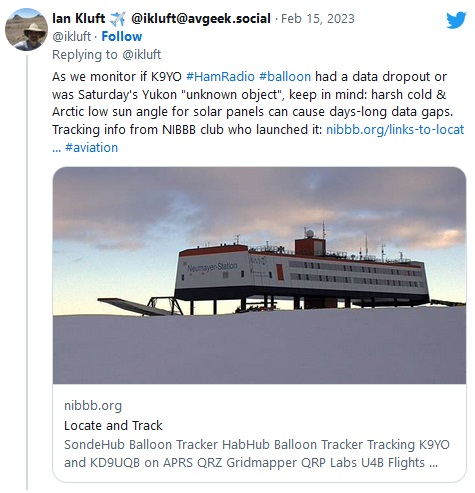Did The USAF Shoot Down a Ham Radio Balloon?
First, I need to do a little background information and introduction to the acronym salad that’s inevitable here.
Sending remotely operated or semi-autonomous balloons on otherwise random trips has become another of the hundreds or thousands of sub-hobbies in ham radio. Large amateur radio balloons, carrying more than four pounds that are launched in the USA require FAA clearance, need a radar reflector attached, and usually continually transmit APRS telemetry before naturally popping and falling back to earth after a few hours, just like a weather balloon. APRS in this sense is the Automatic Position Reporting Service that uses what hams refer to as packet radio to transmit a radio’s location at regular intervals; because of its dependence on packet radio, you’ll see that acronym translated as Automatic Packet Reporting Service.
I’m guessing that because of the FAA requirements for the larger balloons, a sub-sub-hobby got started referred to as pico balloons (literally a billionth of a balloon – but in this case, a small balloon). These are generally the helium-filled, Mylar balloons you might get for a birthday party and carry small, solar-powered payloads that are only a few grams in weight. These can generally be launched from anywhere without FAA approval. What for? Another amateur radio mode that’s currently in wide use is called WSPR, for Weak Signal Propagation Reporter.
WSPR was invented to allow stations to transmit a weak signal on recommended frequencies in any of the different amateur bands so that anyone can see at a glance if a band they’re interested in is “open” to some part of the world. The transmit power is at the discretion of the operator, so some guys will send milliwatts and others will send several watts. The idea started as a beacon network, where stations around the world transmitted on a schedule and reported what they heard to the internet. Similarly, one can transmit a WSPR “ping” from their station and look up what other places heard their ping. A pico balloon can carry a small, low power transmitter and GPS receiver, with a small solar cell array, and by using the WSPR network, determine where the balloon is. A well-designed pico balloon can drift around the world several times and its path mapped. As you might expect there are clubs like the NIBBB, where the hams who want to do this hang out and help each other.
Which brings us to what may be the News Story of the Year:
There is speculation that at least one of the objects shot down over Canada, Yukon by a US Air Force jet may have been amateur radio pico balloon K9YO-15 which was launched from Illinois on October 10 2022. It was on its seventh circumnavigation of the globe after being aloft for 123 days.
What RTL-SDR reports is that this was a silver mylar 32″ spherical balloon, similar to or even exactly this one from balloons.online. The payload was a GPS module, Arduino, SI5351 clock generator used as a WSPR and APRS transmitter and a solar panel, all together weighing 16.4 grams.
The K9YO-15 balloon ceased all WSPR telemetry transmissions while flying just below Alaska since Feb 11 00:18 UTC (just before sunset in Alaska when the solar panels would stop working).
By using NOAA wind models and the last known location by Alaska, K9YO-15 was projected to have been over Yukon when the US Air Force shot down the unknown balloon object at Feb 11 20:41 UTC (3:41 PM EST / 1:41 PM Yukon time according to Canadian Defense Minister Anand). Reports put the altitude of the shot down object at approximately 40,000ft (~12000 meters), which matches the projected ~11500 meters of K9YO-15. Based on the previous days transmission times, it is suspected that if it were operational, the balloon would have begun transmitting again sometime later in the Yukon afternoon when the sun was stronger, but no transmissions have been seen.
The last reported position from K9YO-15 is indicated by the yellow triangle, with the projected path shown. The balloon was at the black star, closest to an uninhabited Alaskan island called Hagemeister island, when this forecast path was created.
The yellow star works out to be around the Yukon cities of Dawson City and Mayo. The area is being searched, but nothing has been found. It’s a big area and the K9YO-15 balloon is small; if it was blown up by some sort of weapon, the debris is going to be even smaller than that 36″ balloon linked to above. Over on Twitter, @ikluft (KO6YQ) reported on this speculation, and kept monitoring for K9YO-15 for several days. Yesterday, he tweeted that while the balloon hadn’t been heard for days, that’s not unexpected in the long, dark winter nights of the arctic. The NIBBB club officially lists the balloon as “missing in action.”
There’s a mental picture that goes with this all; a handful of ham radio pico balloons around the world getting tracked down by the most advanced militaries in the world and shot out of the sky. Reading around shows a cost for these missions to take out a $50 ham project as between 1 and $2 million. Burning that as dollar bills would be more useful; at least you could get warmed by the fire or make some coffee or something.


